Column An Exhaustive List of the Surgeries Available for Disc Herniation: We’ll Reveal the Costs, Advantages and Disadvantages of Each, and Who These Surgeries are for (Written by a Medical Practicioner)
The most prevalent spinal condition in the world is said to be disc herniation.
If a lumbar disc herniation occurs, symptoms such as lower back pain and pain and numbness in the legs will occur, interfering with your work and daily life.
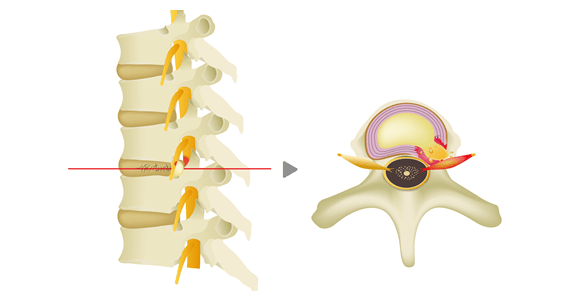
Your doctor may recommend conservative treatment or surgery.
This time, we will explain each type of surgery for herniated discs.
Surgery
Surgery for herniated discs varies depending on the medical facility.
LOVE Method
Under general anesthesia, a 5-10 cm incision is made on the back, and while avoiding the nerves under visual observation, parts of the ligaments, vertebral arch, etc. are scraped or cut open to remove the herniated portion at the back.
| Advantage | Disadvantages |
| ・Can handle moderate to severe disc herniation ・Less likely to miss lesions during surgery under visual control ・Covered by Japanese health insurance | ・The incision is large (5-10 cm). ・Part of the ligaments and bones are cut or scraped, so the body is under a lot of strain. ・Hospitalization is long, at 2-3 weeks. |
| cost | Approximately 70,000 yen (30% copayment) + hospitalization costs |
Microscopic Lumbar Disc Herniation Surgery (MD Method)
Under general anesthesia, a skin incision of about 2-3 cm is made in the lumbar region. A tubular instrument is used to remove the hernia under a microscope. The surgery is performed under direct vision while checking with a microscope, so there is little damage to nerves or the dura mater. There is almost no pain at the incision site, but there is little bleeding, and you will be able to walk the next day. The hospital stay will be about 1-2 weeks.
| Advantage | Disadvantages |
| ・Because surgery is performed under a microscope, the depth of the surgical field can be clearly seen, and there is less risk of nerve damage than with endoscopic surgery. ・It is covered by health insurance. | ・The incision is large, at 2-3 cm. ・The hospital stay is long, at 2-3 weeks. |
| Cost | 220,000 to 275,000 yen (30% copayment) + hospitalization costs |
Endoscopic discectomy (MED method)
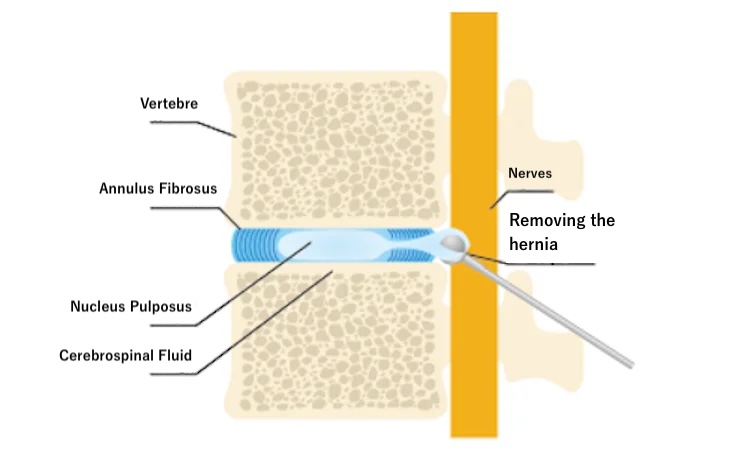
Under general anesthesia, a 16mm incision is made on the back, and the protruding hernia is removed while being confirmed with an endoscope. There is little muscle detachment, and postoperative pain is minimal. In addition, postoperative scars are small, and hospitalization is approximately 1-2 weeks.
| Advantage | Disadvantages |
| ・The surgery takes about an hour, which is a relatively short time. ・There is little muscle detachment, and postoperative pain is minimal. ・It is covered by health insurance. | ・The postoperative scar is rather large at 16 mm. ・The hospital stay is about 1 to 2 weeks. ・The surgical technique requires skill, so the surgery can only be performed at specialized hospitals. |
| Cost | 231,000 to 300,000 yen (30% copayment) + hospitalization costs |
Percutaneous Endoscopic Herniectomy (PELD)
If the size of the herniated disc is large and the pain is quite strong, PELD surgery may be performed. Under local anesthesia, a tube called an operating tube is inserted from the back, and the herniated area is removed while being confirmed through an endoscope through the tube. The incision is small, the postoperative scar is not noticeable, and the postoperative pain is not great. The hospital stay is about 2 to 4 days.
However, it is said that it is difficult to perform the PELD method when the intervertebral space is narrow or when spinal stenosis or spondylolisthesis is also present.
Functional Endoscopic Sinus Surgery (FESS)
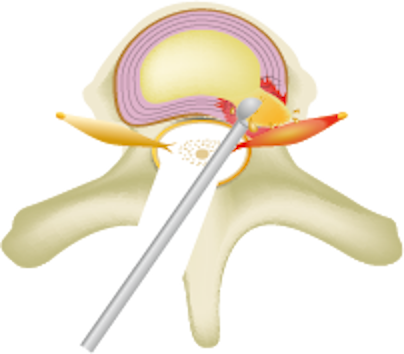
This is a surgery for herniated discs and lumbar spinal canal stenosis. An incision is made about 1 cm into the back, and the outer tube for the endoscope is passed through to remove the herniated disc or to widen the narrowed spinal canal using a drill. Spinal processes and ligaments may be scraped to allow the endoscope to pass through. Hospitalization is required for 3 to 5 days.
| Advantages | Disadvantages |
| ・Postoperative scars are small, about 1 cm. ・Health insurance is applicable. | ・The spinous processes and ligaments may need to be scraped to pass the endoscope through, which places a great strain on the body. ・Hospitalization is about 3 to 5 days. |
| Cost | 200,000 to 250,000 yen (30% copayment) + hospitalization costs |
Spinal fusion surgery
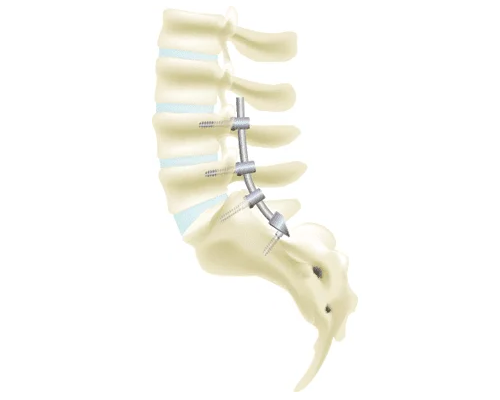
The type of spinal fusion being performed in Japan these days is endoscopic spinal fusion. It is a surgery to fix the intervertebral bodies using an endoscope and X-ray fluoroscopy. Under general anesthesia, the back is incised about 2 to 3 cm, the problematic intervertebral disc is removed, and the upper and lower vertebrae are inserted into a titanium cage and fixed with screws and rods. A hospital stay of 1 to 2 weeks is required.
| Advantage | Disadvantage |
| ・If the lumbar spine is unstable, the unstable part can be fixed. ・It is covered by health insurance. | ・It is highly invasive and leaves large scars ・Hospital stay is long, at 1 to 2 weeks ・Metal screws inserted into the body can damage muscles and restrict movement of the lower back ・Once fixed, it cannot be made to move again ・After surgery, stress is placed on the adjacent intervertebral discs, which can lead to spinal stenosis or herniated discs ・If bones are weak due to osteoporosis, the fixed vertebrae can collapse ・There is a high possibility that pus will accumulate in the area where surgery was performed |
| Cost | 600,000 to 850,000 yen (30% copayment) + hospitalization costs |
Intervertebral disc treatment
In recent years, unlike the general surgical method of removing the herniated portion, disc treatment that approaches the damaged disc has also been performed. Unlike surgical procedures, hospitalization may not be required and treatment can be completed on an outpatient basis.
Percutaneous Laser Disc Decompression (PLDD)
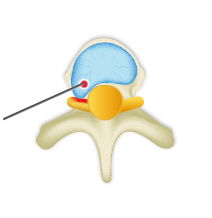
Under local anesthesia, a needle is inserted from the back into the affected area of herniated disc, a laser fiber is passed through the needle’s path, and the nucleus pulposus inside the disc is burned with the laser, creating a cavity in the nucleus pulposus and causing the disc to shrink.
| Advantage | Disadvantage |
| ・Effective not only for herniated discs but also for non-specific lower back pain. ・Less physical strain on the patient than the MED or LOVE methods. ・Treatment time is about 15 minutes, so treatment can be completed on an outpatient basis. | ・Not applicable to all cases of herniated discs ・Not covered by health insurance |
| Cost | 308,000 to 495,000 yen (100% coverage) |
Percutaneous Ozone Disc Decompression (PODD)
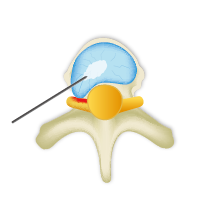
Under local anesthesia, a needle is inserted into the affected herniated disc from the back, and a mixture of ozone and oxygen is injected from the tip of the needle, reducing the volume of the herniated disc and relieving pressure on the nerves.
Private medical treatment
Length of stay: Half a day
Cost: 330,000 yen (Not covered by insurance)
| Advantages | Disadvantages |
| ・Surgery time is short and postoperative scars are small ・There is little risk of side effects or complications ・Treatment can be done on an outpatient basis ・It is a less invasive surgery than PLDD, and there is no risk of discitis, which rarely occurs due to the heat of the laser | ・Not effective for all hernias ・Pain relief is weak, and multiple treatments may be required ・Not covered by health insurance |
| cost | 330,000 yen (100% burden) |
Hybrid Laser Treatment
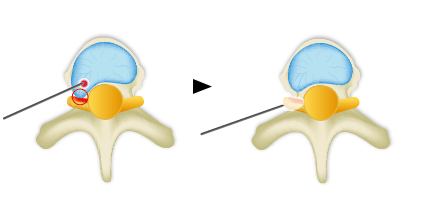
Under local anesthesia, a laser is used to shrink the protruding hernia, and ozone is injected to suppress radiculitis.
| Advantages | Disadvantages |
| ・The operation time is short and the postoperative scar is small. ・It is more effective than PLDD or PODD because it can simultaneously eliminate hernias and treat inflammations. | ・Not effective for all hernias ・Not covered by health insurance |
| Cost | 440,000 yen (100% burden) |
Intradiscal enzyme injection therapy (Hernicore)
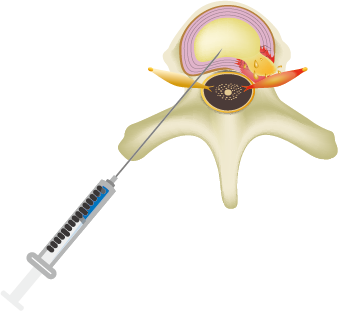
Intradiscal enzyme injection therapy changes the composition of the intervertebral disc by injecting a drug containing an enzyme into the intervertebral disc, causing the herniation to disappear. Usually, hospitalization for 1 to 2 days is required. Intradiscal enzyme injection therapy can only be performed once in a lifetime, and a second treatment on the same disc is not possible.
| Advantages | Disadvantages |
| ・Surgery time is short and postoperative scars are small. ・Health insurance applies. ・Hospital stay is short, 1-2 days. | ・It can only happen once in a lifetime and cannot be re-treated. ・Depending on the shape of the hernia and its location, treatment may not be appropriate. |
| Cost | 60,000 to 70,000 yen (30% copayment) |
Cellgel method

The Cellgel Method is a treatment that can “repair the intervertebral disc,” which was not possible with other treatments. It is one of the advanced treatment methods that has been researched and developed in recent years, and is a treatment with solid evidence.
This can be a definitive treatment, as a material that fills the cracks in the damaged intervertebral disc is injected into the disc, which then turns into a gel and repairs the cracks. The volume of the intervertebral disc does not decrease, and the material remains in the intervertebral disc as a gel implant after treatment, so the disc is preserved.
| Advantages | Disadvantages |
| ・It is possible to “repair the intervertebral disc,” which was not possible with other treatments, and can be a definitive treatment. ・It can be applied to a wide range of diseases, not just herniated discs. ・Treatment can be done on an outpatient basis. ・People who have not been able to relieve pain after surgery or who have experienced a recurrence can receive treatment. ・Even people over 80 years old can receive treatment. | ・If the intervertebral disc has collapsed and almost disappeared, the treatment is not applicable. ・The treatment costs are high because it is an elective medical treatment. |
| Cost | 1,320,000 yen (100% burden) and up |
Herniated Disc Surgery: Summary
| Cellgel Method | Hernicore | Hybrid Laser Treatment | PODD | PLDD | FESS | PELD | MED | MD method | LOVE Method | Spinal Fusion Surgery | |
| Intervertebral Disc Repair | 〇 | × | × | × | × | × | × | × | × | × | × |
| Disc Preservation | 〇 | 〇 | △ | △ | △ | △ | △ | △ | △ | △ | × |
| Anesthesia Type | Local anesthesia | Local anesthesia | Local anesthesia | Local anesthesia | Local anesthesia | General anesthesia | Local anesthesia | General anesthesia | General anesthesia | General anesthesia | General anesthesia |
| Treatment time | About 15 minutes | About 10 minutes | About 25 minutes | About 15 minutes | About 15 minutes | 30 minutes to 1 hour | 1 hr | 1 hr | 1 hr | 1–2 hours | 1–1.5 hours |
| Scar | Less than 1mm | Less than 1mm | Less than 1mm | Less than 1mm | Less than 1mm | 1 cm | 6 to 7 mm | 16mm | 1-3cm | 5-10cm | 2-3cm |
| Length of hospital stay | None | 1–2 days | None | None | None | 3–5 days | 2–4 days | 1–2 weeks | 2–3 weeks | 2–3 weeks | 1–2 weeks |
| Insurance Coverage | Private medical treatment | Insurance-covered medical treatment | Private medical treatment | Private medical treatment | Private medical treatment | Insurance-covered medical treatment | Insurance-covered medical treatment | Insurance-covered medical treatment | Insurance-covered medical treatment | Insurance-covered medical treatment | Insurance-covered medical treatment |
| Return to daily life | The next day | After discharge | The next day | The next day | The next day | After discharge | After discharge | After discharge | After discharge | After discharge | After discharge |
| Chance of Recurrence | none | Possible | Possible | Possible | Possible | Possible | Possible | Possible | Possible | Possible | Possible |
Article Author

Orthopedic surgeon Yuko Maruyama
Affiliated societies and qualifications
Specialist and instructor of the Japanese Society of Anesthesiologists
Ministry of Health, Labor and Welfare certified anesthesiologist
JB-POT
Pain Clinic Society
Japanese Society of Cardiovascular Anesthesiologists
Cellgel method certified doctor
Florence method certified doctor



